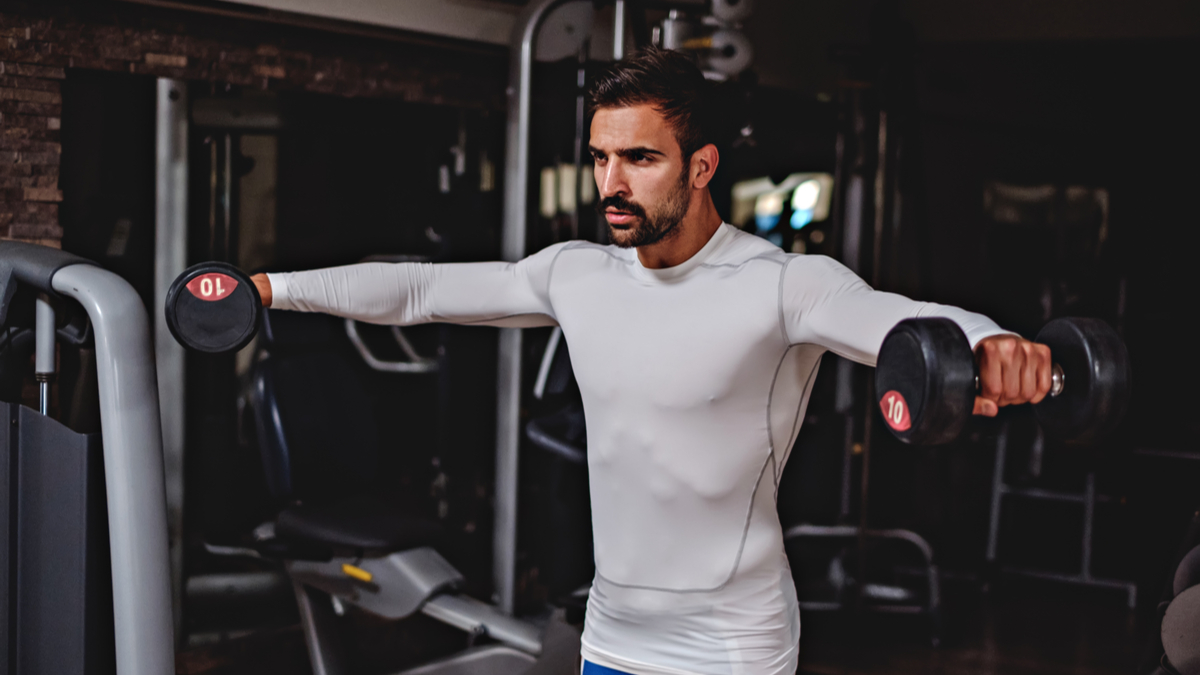Products You May Like
If you plan on being in the gym long-term, you need to avoid beating up your joints. The shoulders, in particular, can be tough to train intensely without excessive wear and tear. Fortunately, the lateral raise can be a very effective way to build the shoulders without attacking the joints.
Beyond joint-friendly training, if you want to look great but haven’t added lateral raises into your workouts, two words should convince you otherwise: boulder shoulders. You can bench and overhead press all you want, but you still won’t see a set of broad, round, fully developed shoulders in the mirror.
The lateral deltoid is underdeveloped in many lifters due to the lack of direct stimulation from many compound exercises. Add lateral raises to your program, and you’ll close the gap in developing well-rounded shoulders. Let’s break down everything you need to know about performing this beneficial exercise.
How to Do the Lateral Raise
The lateral raise seems simple enough. Grab hold of some dumbbells, raise them out to the side, lower them down, and repeat.
The shoulder is a tricky piece of machinery, and if poor technical habits are engrained, they may lead to an increased risk of injury. Let’s give you the rundown on performing this exercise perfectly.
Step 1 — Find the Starting Position
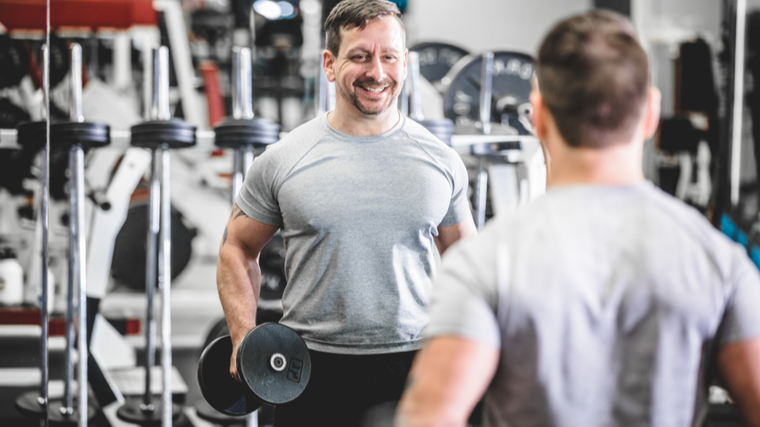
Stand up straight with your arms at your sides and a dumbbell in each hand. Position your feet just inside shoulder-width apart and brace your core. Lean forward slightly and allow the weights to touch each other in front of your thighs. Your palms should be facing each other and your elbows should be very slightly bent.
Form Tip: Slightly bending at the hips will shift your center of gravity and help to keep yourself grounded as long as you also tense your core. It also elicits a greater range of motion for the shoulder to move through, compared to keeping the weights at your sides.
Step 2 — Raise to Shoulder-Level
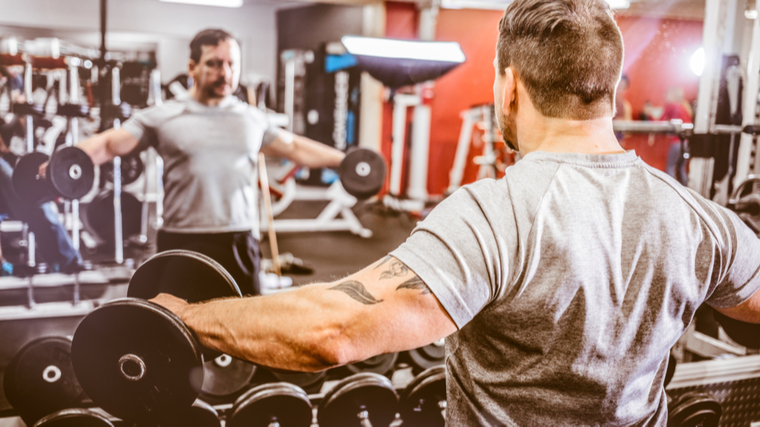
Maintain a neutral grip (palms facing your body) and keep your elbows in a softly bent position. Initiate the raise by driving out and up through your elbows until your upper arm is parallel to the floor. As the weights come up, your hands should naturally rotate to point your palms towards the ground.
Focus on moving your elbows to lift the weight, not leading with your hands. Your shoulders should be kept down, not shrugged up towards your ears.
Form Tip: Think of standing on the face of a clock. During the movement, your left arm should be pointing between nine and ten and your right arm should be between two and three. Keeping your arms in this alignment will better serve shoulder health while maintaining tension on the muscle.
Step 3 — Lower to Stretch
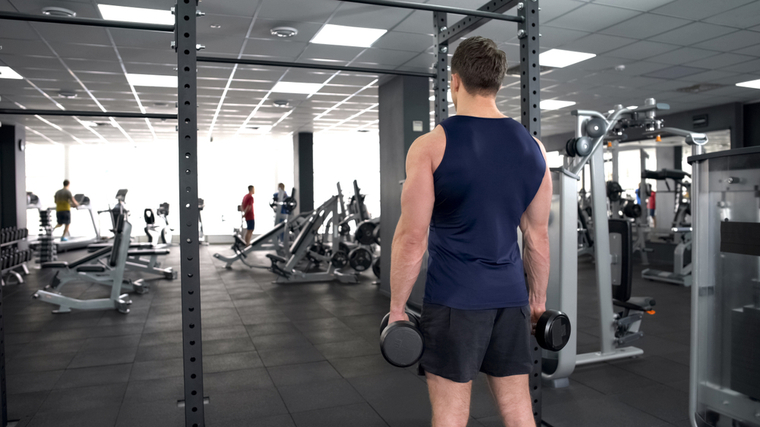
Maintain tightness through your core and lower body as you lower the weights along the same path. Use a controlled tempo, taking one to two seconds. The dumbbells should end up in the starting position touching each other in front of your thighs.
Form Tip: Rest in the bottom position for one second before starting the next rep. This will lessen any momentum being used to drive up the dumbbells.
Lateral Raise Mistakes to Avoid
While the lateral raise may seem easy enough to perform, there are some important mistakes that must be avoided to prevent any unnecessary risk of injury.
Lifting the Dumbbells Above Your Head
While lifting with a large range of motion can sometimes provide greater benefits in building muscle, in this case more is not better.
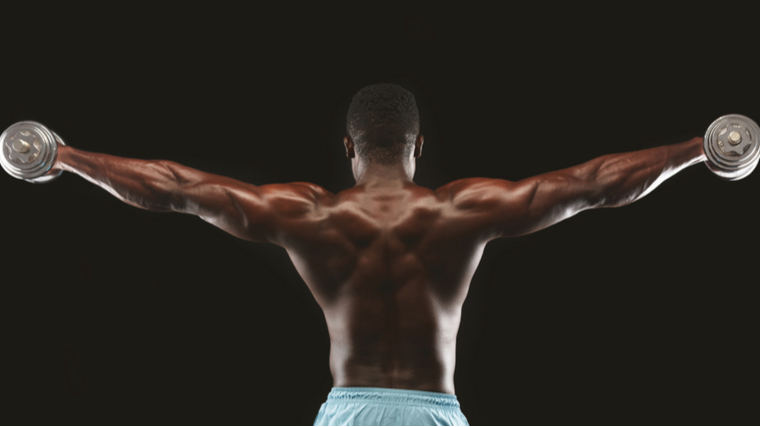
Lifting your arms too high (bringing the upper arms well-above shoulder-level) can place you at risk of an impingement in the shoulder, which is one of the most common causes of shoulder pain. (1)
Avoid It: Imagine you have a barbell across your upper back, much like when performing a barbell squat. As you raise the dumbbells upwards, think about the barbell. Once your upper arm “touches” the bar, lower the weights down.
Lifting Too Much Weight
A lot of gym-goers can be seen using a weight that is so heavy it forces them to use momentum to complete the lateral raise.
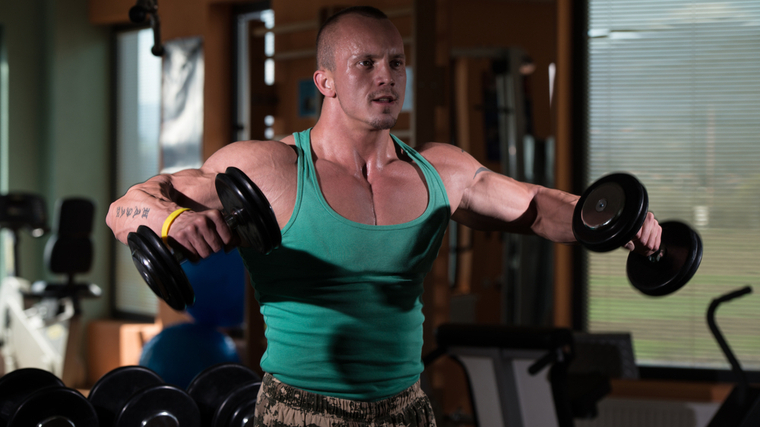
This form of “cheating” will allow you to move more weight, but it also means that you lose a lot of the tension being placed on the target muscle. This goes against the objective of the exercise, which is to maximally recruit and stimulate the lateral deltoid.
Avoid it: Leave your ego at the door. Use a weight that you can lift with control for at least six reps. Keep your entire body tensed to maximize stability and reduce any chance of momentum being used.
Over-Rotating the Wrists
In order to increase the activation of the lateral delt, many lifters dramatically rotate their wrists during each rep, tipping their thumbs towards the floor and their pinkies towards the ceiling (imagine pouring a glass of juice). (2)
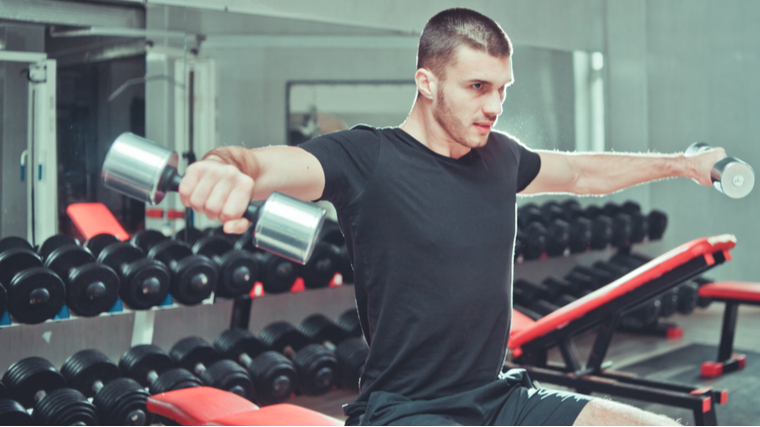
At first, this sounds like a great technique to implement into your training due to the increased muscle activation. However, further studies have also shown that using this technique can increase your shoulders’ vulnerability and increase your risk of injury. (1)
Avoid it: Ensure that your palms, not your thumbs, are pointed towards the ground in the top position of each rep.
Benefits of the Lateral Raise
The benefits of the lateral raise are largely aligned with strengthening the shoulder and improving muscle development through isolating the side shoulder (lateral deltoid) muscle.
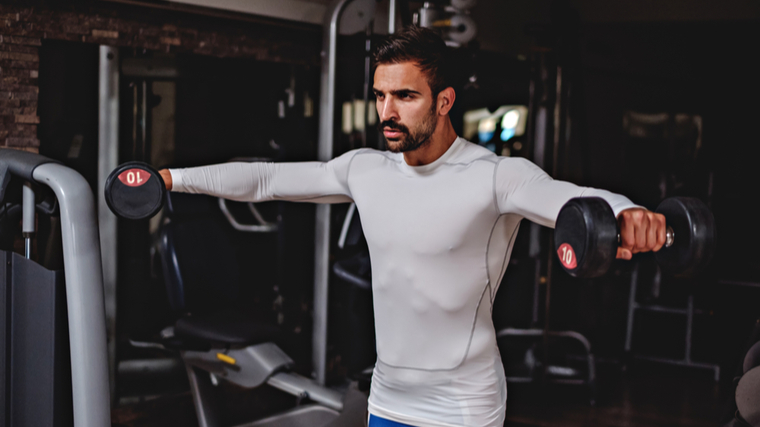
Shoulder Strength
The shoulder muscle is most commonly trained with various types of overhead pressing. However, directly training the lateral deltoid head with lateral raises, similar to directly training the front and rear heads of the shoulder, carryover to improved pressing strength.
Well-Balanced Upper Body Appearance
The lateral deltoid is a muscle that is not effectively or efficiently stimulated in many compound exercises, which can leave them lagging and under-developed. The lateral raise can specifically isolate this muscle allowing you to build a more balanced and aesthetic upper body.
Muscles Worked by the Lateral Raise
The shoulder joint has a very high degree of freedom, which means the shoulder muscle can perform a variety of functions. The shoulders are anatomically split into three heads — the anterior (front), the lateral (side), and the posterior (rear).
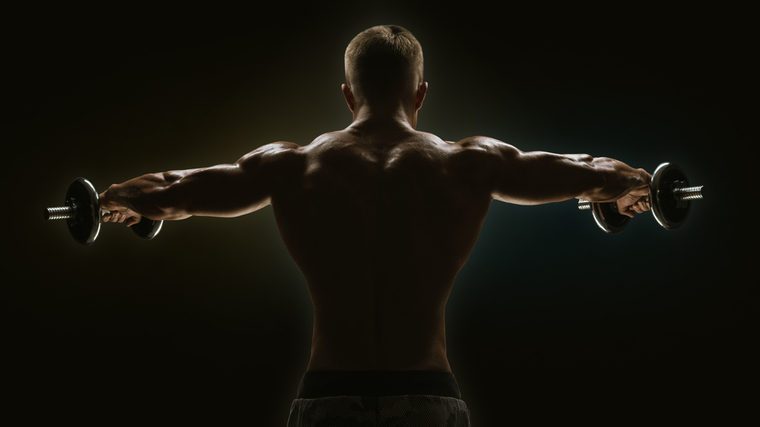
The lateral raise trains all three heads of the deltoids, but the movement is most effective at isolating the lateral head, hence the name of the exercise itself.
Lateral Deltoids
The lateral delts are most visible in the center part of the shoulder muscle. They connect your upper arm to the acromion process on top of your shoulder blade. This head of the shoulder assists in moving your arm out to the side and away from your body, which is the exact movement performed during the lateral raise.
Anterior Deltoids
The anterior, or front, delts are found just above the biceps. They connect your upper arm to your shoulder blade. While they primarily work to bring your arm in front of your body, they are recruited during lateral raises.
Posterior Deltoids
Your posterior, or rear, delts are on the back section of the shoulder muscles. They attach your upper arm to a different section of your shoulder blade. The rear delts function to move your arms behind your body and help control your scapulae (shoulder blades). The posterior delts are significantly recruited during lateral raises, particularly while your torso is slightly bent forward during the exercise.
Trapezius
The trapezius is a relatively large muscle found along your neck and upper back. It isn’t, and shouldn’t be, a primary mover during the lateral raise, but it’s recruited as the weight is moved during the exercise. When lateral raises are performed incorrectly (swinging the upper body or shrugging the shoulders up), the traps can “take over” and reduce deltoid activation.
Who Should Do the Lateral Raise
The lateral raise is a good shoulder strengthening exercise and a great choice for lifters who want to maximize their lateral head muscle development.
Training for Strength
The lateral raise supports overall pressing strength by helping to build the shoulders, which are required for all variations of the bench press and overhead presses. Strength athletes looking to move significant weight in any press will build shoulder strength and overall joint health by incorporating the lateral raise.
Training for Muscle
The lateral raise is one of the few exercises to target and specifically emphasize the side delt directly. When performed correctly, you can overload this section of your shoulder without relying on an excessive amount of weight, making it ideal for any lifters looking to increase shoulder size with minimal joint strain.
How to Program the Lateral Raise
To prioritize muscle growth in the side delts, the dumbbell lateral raise should be programmed earlier in the session to capitalize on energy and focus. However, the exercise can also be effective when used to completely exhaust the muscle fibers towards the end of your workout.
Moderate Weight, Moderate Repetition
To build a well-developed set of shoulders, a classic bodybuilding approach working for three to four sets in the six to 12 rep range will increase training volume for the side delts, which is beneficial for building muscle. (3)
Low Weight, High Repetition
Working for two to three sets in the 13 to 20 rep range (or higher) will deliver the best results when using lighter weights, but it is important to ensure you are not just going through the motions when reps get incredibly high. Each repetition should be performed with crisp technique, no matter how many are performed.
High-rep sets with lighter weight can increase total training volume even further. These types of “burnout sets” are ideal at the back end of your workouts to fully exhaust the muscle fibers of the side delt.
Lateral Raise Variations
While the lateral raise will forever be a time-tested movement, there are also a few variations that can be rotated into your workouts for additional lateral delt development.
Machine Lateral Raise
The machine lateral raise can make it more comfortable for lifters to target the side delt. The main benefit is the weight being placed on your forearms or upper arms instead of being held in your hands. No longer will your grip be a limiting factor.
The machine also makes it more difficult to swing the weight into position, requiring more muscle activation.
Seated Lateral Raise
The seated lateral raise makes it next-to-impossible to move your torso without noticing, which ensures the tension is maintained on the side delt and reinforces strict form.
The seated variation is nearly identical to the standing exercise. The key difference is the stable upright position of your torso, which makes any swinging of your torso immediately noticeable.
Lean-Away Cable Lateral Raise
This cable variation places the muscle under a significant amount of tension throughout its entire range of motion and allows for a more constant resistance curve.
The basic dumbbell exercise relies on gravity to provide resistance, which is minimal in the lower portion of the movement. The cable pulley provides steady resistance throughout the entire exercise.
The lean away approach also changes the arm angle so that less emphasis is placed on the rotator cuff, and a greater emphasis is placed on the lateral delt. (4)
Lateral Raise Alternatives
The lateral raise is a great exercise that targets the side delt. However, there are a few alternatives that you can rotate into your programming for variety and more diverse muscle activation.
Single-Arm Dumbbell Upright Row
This unusual but highly effective movement allows for greater freedom at the shoulder joint than the more traditional barbell upright row, which has a reputation for excessive joint stress.
The single dumbbell also allows the shoulder, elbow, and wrist joints to move and adjust for the exact range of motion that feels most comfortable and least stressful on the joints.
Cable Upright Row
This exercise may be the most effective compound movement for lateral delt development due to the significant shoulder abduction (upwards and outwards) component. Using a rope on a low cable pulley gives the shoulder joint more freedom to move, compared to attaching a straight bar to the cable.
To prevent any chance of shoulder impingement or joint strain, don’t allow your elbows to rise up above shoulder-height. To minimize the trapezius being recruited, initiate the movement by pulling the rope handle apart and out towards your shoulders, rather than straight up towards your chin.
FAQs
How heavy should I perform lateral raises?
The side delt is a relatively small muscle and does not require an extremely heavy load to stimulate the muscle. You want a weight that is challenging for the intended rep range, but not so heavy that it forces you to cheat the weight up.
Remember that the goal of the exercise is to stimulate the side deltoid, not to move the most weight.
How many times per week can I do lateral raises?
Throwing in some lateral raises twice per week is going to be more effective than once per week for maximizing growth. (5) As you become a more experienced lifter, it can be worthwhile adding in an extra day per week.
Because the lateral raise doesn’t contribute significantly to overall training stress (compared to a bigger exercise like deadlift), it can be plugged into many other workouts without drastically affecting recovery.
References
- Kolber, M.J., Cheatham, S.W., Salamh, P.A., & Hanney, W.J. (2014). Characteristics of Shoulder Impingement in the Recreational Weight-Training Population. Journal of Strength and Conditioning Research, 28, 1081–1089.
- Coratella, G., Tornatore, G., Longo, S., Esposito, F., & Cè, E. (2020). An Electromyographic Analysis of Lateral Raise Variations and Frontal Raise in Competitive Bodybuilders. International journal of environmental research and public health, 17(17), 6015. https://doi.org/10.3390/ijerph17176015
- Schoenfeld, B. J., Contreras, B., Krieger, J., Grgic, J., Delcastillo, K., Belliard, R., & Alto, A. (2019). Resistance Training Volume Enhances Muscle Hypertrophy but Not Strength in Trained Men. Medicine and science in sports and exercise, 51(1), 94–103. https://doi.org/10.1249/MSS.0000000000001764
- McMahon PJ, Debski RE, Thompson WO, Warner JJ, Fu FH, Woo SL. Shoulder muscle forces and tendon excursions during glenohumeral abduction in the scapular plane. J shoulder Elb Surg. 1995;4(3):199-208.
- Schoenfeld, B. J., Ogborn, D., & Krieger, J. W. (2016). Effects of Resistance Training Frequency on Measures of Muscle Hypertrophy: A Systematic Review and Meta-Analysis. Sports medicine (Auckland, N.Z.), 46(11), 1689–1697. https://doi.org/10.1007/s40279-016-0543-8
Featured Image: Sjale / Shutterstock
